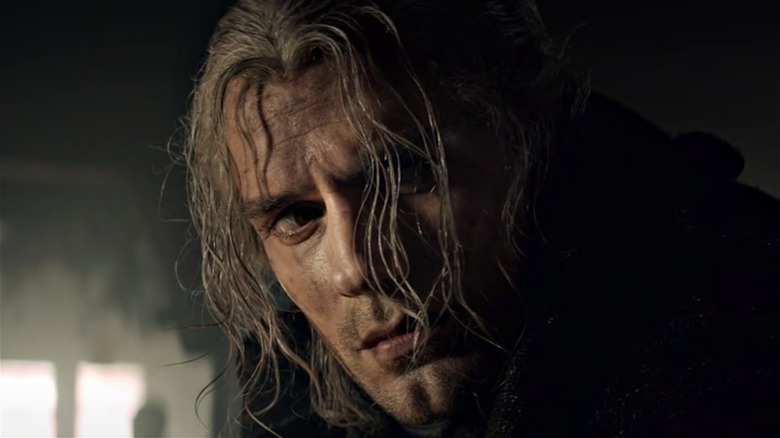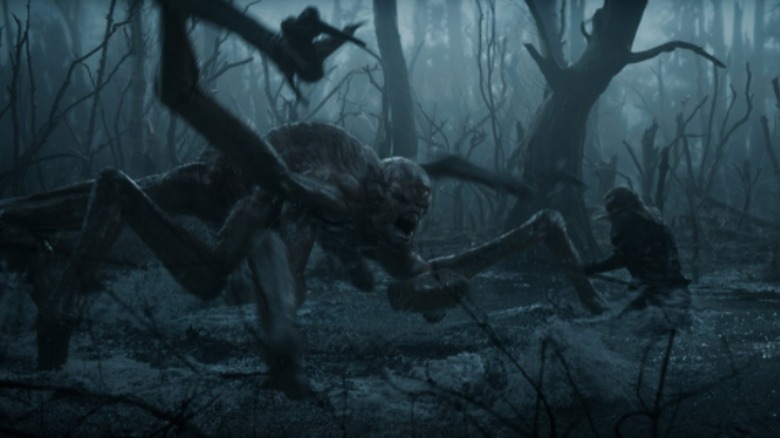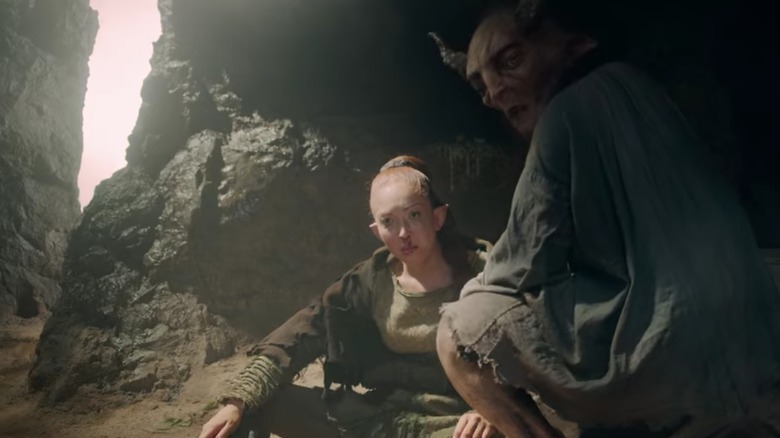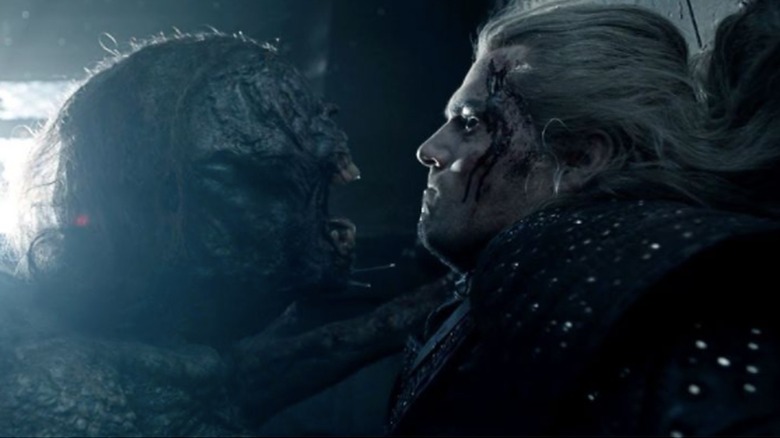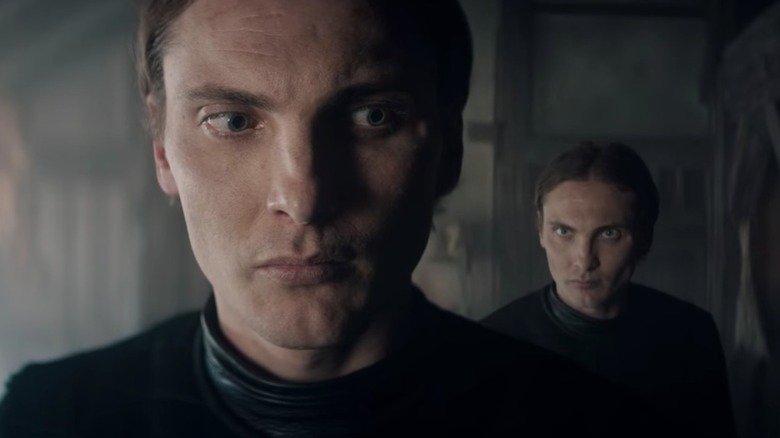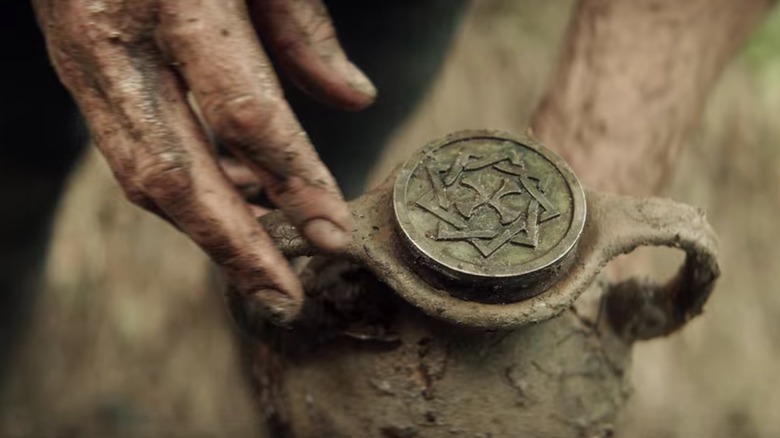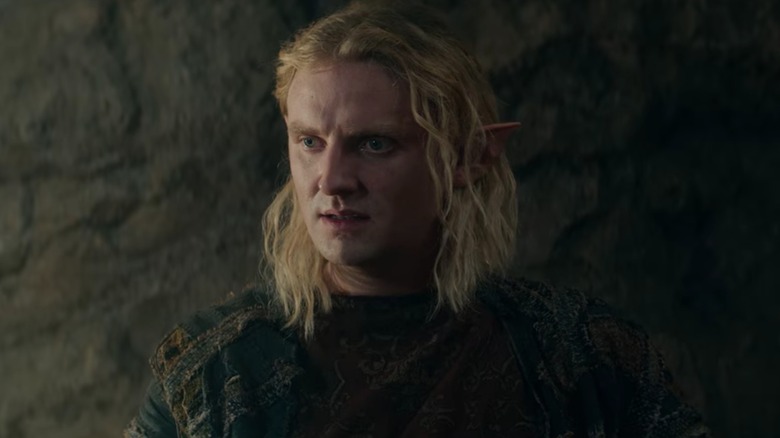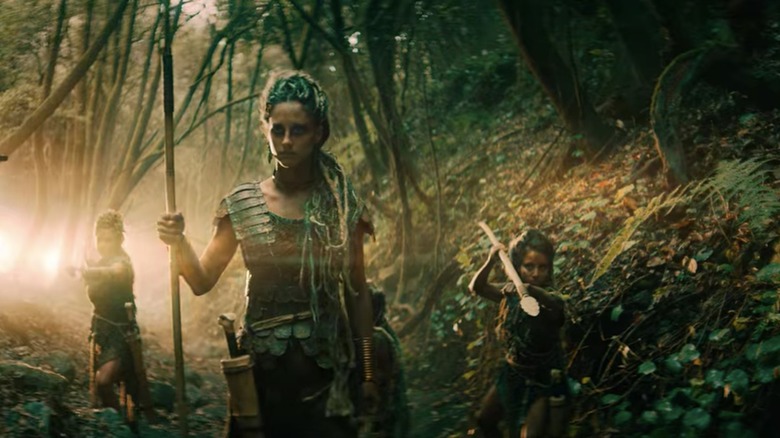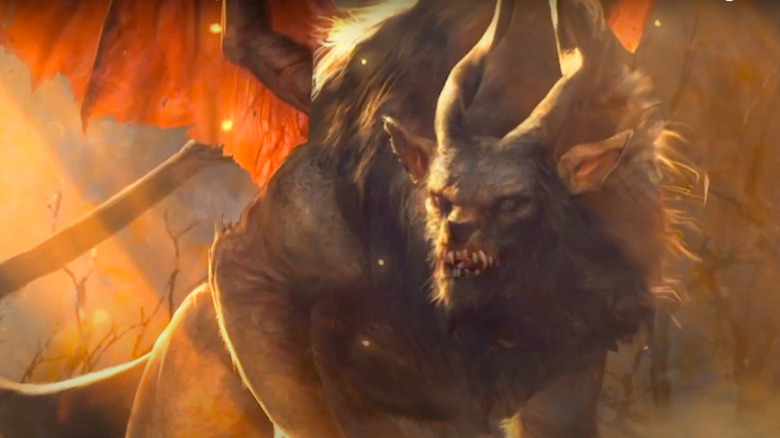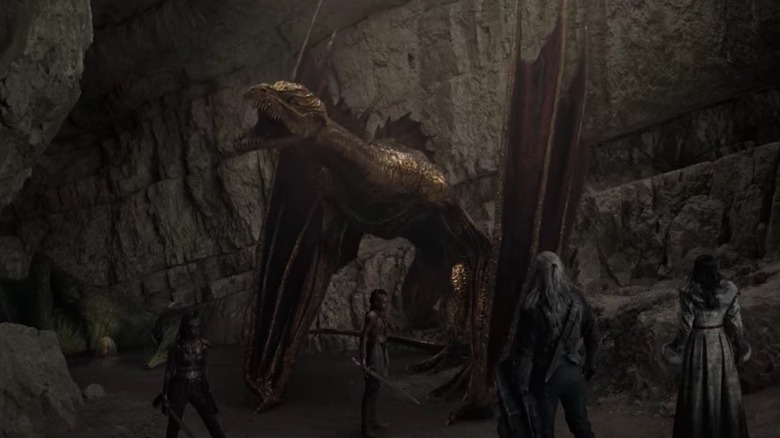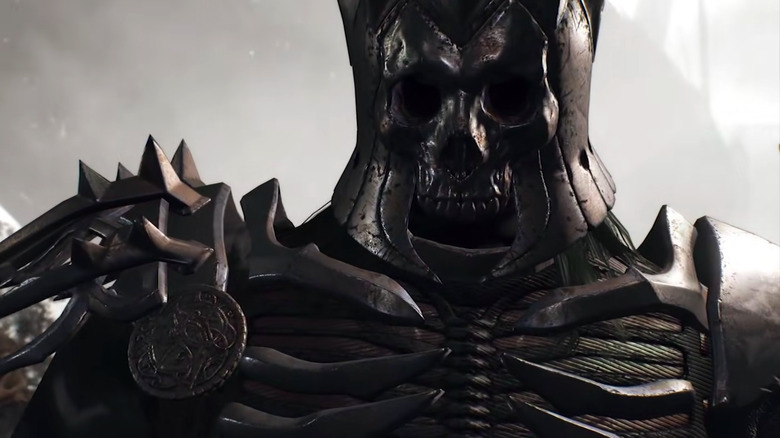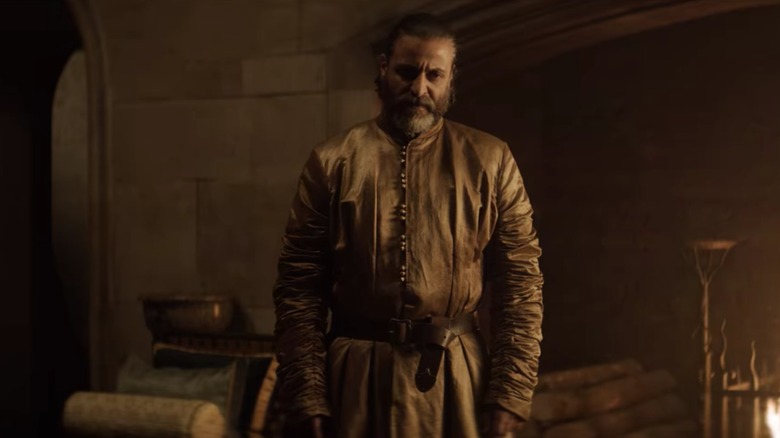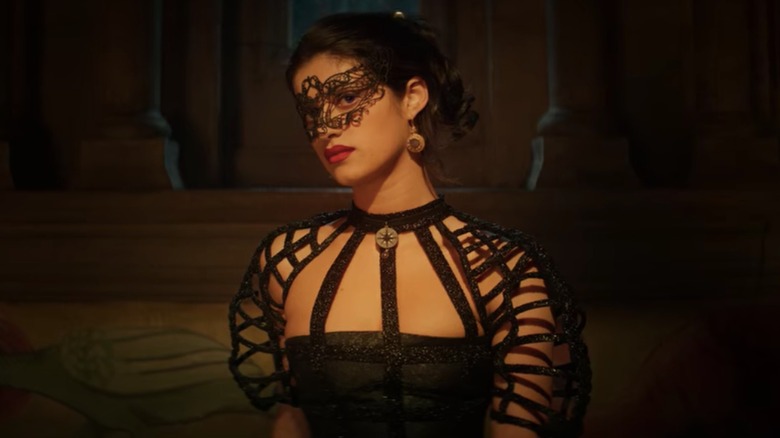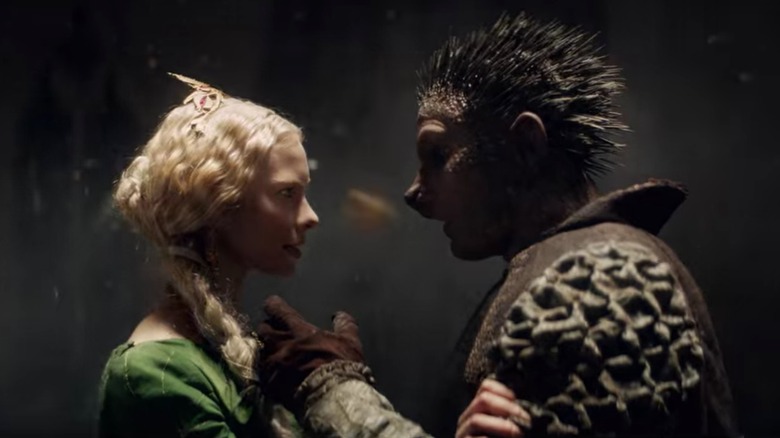Times The Witcher Tapped Into Real Mythology
The release of Season 2 of "The Witcher" sees fans rejoicing, as the series had multiple delays in filming due to the COVID-19 pandemic. While watching Season 1, you might wonder where Andrzej Sapkowski (the Polish author of the book series the show is based on) came up with all the terrifying and fascinating creatures Geralt of Rivia encounters. According to an interview with LitHub, Sapkowski thinks it "would be easier to name the mythologies and cultures [he] DIDN'T draw on."
While Sapkowski took inspiration from the folklore of his native Poland and Slavic mythology, he also drew on Greek, Germanic, and Norse mythology. We also see Persian and Celtic mythology representations in this fantasy series. "The Witcher" sprinkles references to European fairy tales throughout the show, and some characters from historically nebulous classes of society are a part of this fantasy world.
Simply put, the series is an imaginative treasure trove of myths and legends from across the globe, so let's look at the real world myths and folklore that "The Witcher" tapped into in Season 1. Trust us: there's a lot of ground to cover.
Kikimora
When we first lay eyes on Geralt of Rivia in Episode 1 of Netflix's adaptation of "The Witcher," he is fighting a hulking arachnid-like beast in a swamp. Geralt later refers to this monster as a "kikimora" while trying to sell the corpse to a wizard. While the beast in the show is terrifying and dramatic, it is a misrepresentation of what is traditionally known as a kikimora in Slavic mythology. A kikimora is a female house spirit known for causing mischief. According to the New York Public Library, kikimoras typically resemble a deformed woman, disrupting dwellings, particularly homes where a child has passed away.
Although they aren't dangerous, they are known for disturbing the inhabitants of these homes by making noises and leaving wet footprints on the floor. Kikimoras do occasionally inhabit swamps and forests as this creature from "The Witcher" does. We understand kikimora to be married to domovoi, benevolent masculine spirit that protects homes, their inhabitants, and possessions. Domovoi resemble little old men, much like leprechauns. They are believed to age backward, ending their life as an infant — just like Benjamin Button.
Sylvan
In Episode 2, villagers hire Geralt to kill a monster who is stealing the harvest and described as a "devil." When Geralt goes in search of this creature, he tells his companion, Jaskier, that devils don't exist. When he tracks the creature down, Geralt realizes it is a sylvan. Sylvans are forest dwellers that look like the Greek fertility god Pan. With a goat's legs and horns on a human's torso, it isn't surprising people now associate this pagan fertility god with the image of a Christian devil.
This sylvan's name is Torque, and he is stealing the harvest for elves who are in hiding. When Geralt realizes why Torque is stealing the harvest, he resolves to leave the sylvan and the elves alone. It is during this interaction, we come to understand the awful history between elves and humans. Elves helped humans access magic and were then massacred by humans during The Great Cleansing. These elves are in hiding and are the survivors of a horrific genocide. Elves once massacred humans as well, so it is difficult to understand which race is the aggressor in Netflix's "The Witcher."
Sylvans are modeled after the Greek god Pan. Pan's parentage is mysterious, like many Greek gods, but according to some sources, Pan was the son of Hermes and a dryad (a forest spirit from the Greek pantheon). Like his father, Hermes, Pan was a mischievous god who delighted in pranks. Pan is often portrayed as playing pipes, and is associated with merriment, revelry and fertility. Unsurprisingly, as a fertility god, Pan was quite amorous, but the objects of his affection rarely felt the same way. There are many myths about Pan pursuing nymphs, who went to great lengths to avoid his lecherous attention.
Striga
In Episode 3, Geralt attempts to save a cursed striga. In "The Witcher" a striga is the fetus of a Princess who died while pregnant. Rather than dying, the cursed unborn child turns into a vampiric creature who hunts during the full moon, killing any man who enters her castle, and feasting on their blood. In this series, the child is the product of incest, between a brother and sister. As disgusting as this is to modern viewers, many gods and goddesses of ancient mythology are siblings who procreated, thus making an entire pantheon of gods. Even some real royal lines were known for inbreeding. The Habsburg dynasty had a facial deformity, a genetic mutation, linked to their inbreeding.
As Time notes, "the strzyga, the shtriga and the strigoi are different regional variations of a vampiric demon spirit" from eastern Europe. These spirits are the inspiration for Bram Stoker's novel "Dracula," a creature who has captured the imagination of popular culture and Hollywood alike. But modern representations of vampires are infinitely more sexy than this gruesome striga from "The Witcher." This episode highlights the strength of Geralt's character. Although he is a hunter, and often regarded as a monster himself, he has integrity, and won't kill a creature unless it is nefarious. Geralt repeatedly puts himself in danger, trying to help the cursed and misunderstood creatures of his world.
Doppler
In Episode 5 and 6 of Season 1, we meet the unsettling creature known as a Doppler. These shapeshifters can take on the form of their victims, also gaining their mannerisms, voice and memories. According to Witcher Fandom, Dopplers were gentle beings who used their shifting abilities to hide in plain sight amongst humans. Humans hunted these magical creatures, killing them off, a recurring theme in "The Witcher." In Netflix's series, Dopplers are assassins who take on the form of their marks, using their borrowed faces to work as spies. One such Doppler takes on the guise of Princess Ciri's protector, Mousesack, after killing him.
Although there are shapeshifters from numerous cultures, it seems the Dopplers from "The Witcher" are inspired by what in popular culture is known as a doppelgänger, a spirit thought to be an evil twin. These days people use this term lightly, meaning someone with an uncanny resemblance to a stranger. Traditionally, doppelgängers are spirits who look exactly like you and are sinister. As Bustle says, they are "widely considered to be a bad omen, as doppelgängers are supposedly harbingers of darkness, bad luck, and sometimes straight-up evil." Other fantasy shows like "The Vampire Diaries" have their own fascinating version of a doppelgänger in its vampire mythology. In "The Witcher," Dopplers aren't in spirit form, they are corporeal — and they are deadly.
Djinn
In Episode 5, Geralt is cantankerous because he cannot sleep, and has become desperate to find a djinn, hoping to win three wishes, so he can find rest and release from his torment. In our popular imagination, djinn are like the genie in "Aladdin" and from the show "I Dream of Genie." While the djinn in "The Witcher" will grant three wishes, this creature is wrathful. When this djinn injures the bard, Jaskier (played by Joey Batey), Geralt takes Jaskier to a healer. Yennefer and Geralt finally meet, bringing two strands of the developing story together.
Djinn (sometimes spelled jinn) are mythical spirits made of smokeless fire and air from pre-Islamic lore. Traditionally, djinn are characterized as similar to humans. They eat and sleep, live in communities and can die. They are shapeshifters with magical abilities, who are depicted as slaves, imprisoned within a magic lamp. As Vice says, "Neither inherently good nor bad, Jinn are amorphous entities, able to take the shape of humans and animals alike. Their role in society, too, has been malleable," much like the metal they are known for smithing. The djinn in this series not only grants Geralt three wishes, it brings the story lines of two of our most powerful and important characters in the series together for the first time.
Elves
Elves are hardly unfamiliar to us in popular culture. The most familiar version being the diminutive elves who work in Santa's workshop. But before they were Santa's little helpers, they were found in the folklore of numerous European cultures. The elves of light in Norse mythology are as big as humans and live in Alfheim. These Norse elves are the inspiration for Tolkien's elves from "Lord of the Rings." We see positive representations of elves as magical, enlightened beings in both Germanic and Icelandic folklore, but there are also more sinister representations as well. In Celtic folklore from the British Isles, we see dualistic and mischievous representations, where there are light and dark elves. While the elves of Celtic mythology are not regarded as evil, they are mercurial, sometimes helpful and other times malicious or even deadly.
There is great animosity between humans and elves in the world of "The Witcher." Despite this animosity, there are still instances of elves and humans having children together. Yennefer's biological father was half elf, and this information was used against her because of the bigotry humans have toward elves. It seems Andrzej Sapkowski has taken inspiration from the elves of light associated with Norse mythology and J. R. R. Tolkien's seminal fantasy novels. In Netflix's adaptation, elves came to the realm before humans. They helped humans gain access to magic, but later were slaughtered in a genocide called The Great Cleansing. The story of elves and humans is complex and nuanced in the books, and we are curious to see if this is further elaborated upon in the following seasons of the series.
Dryads
In Episode 4 and 5, Ciri escapes into the Brokilon forest, where she meets a race of warrior women who are the guardians of the forest and its magical waters. Dryads are only female and mate with elves or humans for procreation. Sometimes they are also referred to as nymphs. Some humans are transformed into dryads by drinking the Waters of Brokilon. According to Witcher Fandom, "The Water of Brokilon often activates... magical abilities in young girls, in similar way(s) the... mutagens do it in witchers." It is after Ciri leaves Brokilon forest with a Doppler she believes to be Mousesack, that her powers are strengthened giving her mysterious abilities to protect herself and creating a psychic link between her and Geralt in their dreams.
Sapkowski took his inspiration for dryads and nymphs from Greek mythology. According to Encyclopedia Britannica, dryads are nature spirits who take the form of beautiful young women and inhabit trees. In Greek mythology, there are two kinds of dryads, spirits that live within a specific tree called hamadryads, and those that live freely within the forest. A hamsdyad's lifespan is directly linked to the tree they inhabit, making them especially invested in protecting their forest. The guardians of the Brokilon forest are dryads who move freely within the forest, using their magical abilities to manipulate the trees, and their archery abilities to fight invaders.
Manticore
In Episode 4, Geralt overhears two courtiers bragging about fighting a manticore, at a party he attends with Jaskier, the bard. Although we never see this creature in Season 1, it is a character in the video games, looking a little different from real world mythological representations (but we hope to see one in Season 2 of "The Witcher").
The manticore is a creature from Persian mythology, described as looking similar to an Egyptian Sphinx. With the head of a man, the body of a lion, and a tail similar to a scorpion's, capable of stinging its prey with poison. The manticore was said to have a predilection for human flesh, appearing to their victims as an old man before striking, and leaving no remains behind. Manticore were considered "unconquerable" apex predators in Persian lore, but it was once rumored a manticore was killed and given to the Persian King Artaxerxes II while Ctesias, a Greek physician, was visiting his court. Ctesias brought word of the legendary beast to the Greek pantheon.
Dragons
In Episode 6, Geralt and Yennefer are brought back together after their tryst, when they join a hunting party for a dragon. Dragon legends can be found in cultures from far-flung regions of our planet. From Mesopotamia and China to Arthurian legends, "Game of Thrones" and Disney films today, dragons have captured our mythic imagination. In ancient Asia, dragons are wingless wise serpents. Benevolent beings with magical powers over storms and water. In China, they are revered and thought to ward off evil, while in western culture dragons are feared and associated with breathing fire, death, and destruction.
In Medieval times, dragons began to be depicted as fire-breathing, winged-beasts, guarding treasure troves in western mythology, even finding their way into Christianity with legends like the Leviathan. In some legends, a dragon's blood had magical properties, giving people prophetic visions of the future. It was also said a sword dipped in dragon's blood would make a wound that could not heal. The dragon from "The Witcher" is a blend of Eastern and Western mythological representations. Like Asian dragons, it is wise, capable of speech and transforming into human form; but also a fearsome winged creature, as we see in European fairy tales of brave knights and beautiful princesses.
The Wild Hunt
Although it is only mentioned in passing a few times in Season 1 of "The Witcher," as an omen of impending war, the Wild Hunt is certain to be a larger part of the show, because of its connection to Ciri in the books. The concept of the Wild Hunt was borrowed from European mythology, but adapted by Andrzej Sapkowski to fit the more complex story of "The Witcher." In the books, the Wild Hunt is a troop of warrior elves searching for slaves from other realms, setting their sights on Ciri, when they sense something special in her blood.
In European mythology, the Wild Hunt can be found in Celtic, Norse and Germanic mythology. It is a cavalcade of spectral riders who make chase across the night sky, bringing death to those who set their eyes upon it. In European folklore, the Wild Hunt is seen as an omen of war, famine, plague and death. While in Irish folklore, the Wild Hunt is known as the Fairy Cavalcade. In Norse mythology it is Odin, the all father, who leads the hunt, and in Germanic folklore it is Wotan. Although it is not unusual for the hunt to be led by female warrior goddesses, or sometimes by a psychopomp, taking souls to the underworld. The Wild Hunt mythology spread throughout Europe, taking on local distinctions and beliefs wherever it roamed.
Druids
A druid is mentioned in conversation between Jaskier and Geralt in Episode 5 of Season 1. Although it is not addressed directly in the series, Ciri's protector, Mousesack, is a druid in the books. This is an instance where "The Witcher" not only borrows from real world mythology, but world history. Druids were a class of learned men (possibly women, but there is little historical evidence) in ancient Celtic culture, who were priests, judges, advisors, healers, and bards. The ancient Celtic pagan religion was persecuted and wiped out by Roman rule in the Isles that would later become Britain. Because of this annihilation, accurate historical information about druids and Celtic pagan traditions has been lost, and what does exist is most likely twisted by the bias Romans felt toward pagans.
These nebulous historical accounts of druids' place in society only strengthen the aura of mystery and magic that envelops them. Druids have become popular characters in European folklore and modern fantasy, finding their way into the mythos of "The Witcher." Arguably the most well known druid is Merlin, King Arthur's advisor and sorcerer. Like the fabled King of Camelot, there has long been speculation amongst historians connecting both Arthur and Merlin to historical figures who emerged out of the chaos the Roman legions left behind when they abandoned the Isles with the fall of the Roman Empire. Whether there is any validity to these theories, one thing is certain — Merlin and druids are here to stay in the fantasy genre.
Mages
Mages, sometimes called The Magi, much like druids, are mysterious figures we find in both historical references and regional folklore. Yennefer becomes a mage after she ascends, signaling the end of the magical training at Arteuza.
Historically, magi played a similar role as visors to the throne. As the New World Encyclopedia states, "Magi refers to a class of ancient Zoroastrian astrologer-priests who once lived in the Persian Empire." They are also widely associated with the three wise men who brought gifts to the infant Jesus. The word magic itself has its roots in the magi of the Persian Empire, linking these mysterious historical figures to folklore representations of magicians, wizards and sorcery, as they are in Netflix's "The Witcher."
As we see from Yennefer's extensive time spent learning how to control the chaos that makes magic, a mage in the world of "The Witcher" is skilled at healing and battle magic. They are also remade beautiful and ageless when they ascend, officially graduating from Aretuza, before advancing to a position of royal advisor at court.
Beauty And The Beast
Netflix's "The Witcher" is filled with references to popular fairy tales. We are told of princesses locked in towers repeatedly during Season 1, a thinly veiled reference to Rapunzel. Episode 1 tells us the tale of Renfri, a rebel who was once a princess, living a gruesome version of Snow White. These storylines, inspired by well-known fairy tales, are all tied to the curse of being born during a black sun. These fairy tale representations are also linked to the law of surprise, as we see in the story of Ciri's parents. Theirs is a love story we all know quite well, the tale of a beauty and her beast.
While it is not the Disney version we know (as it has elements of political machinations and courtly love), it is the story of a man cursed to look like a beast, and the woman who sees past his appearance to the goodness of his heart. In Episode 4, we learn how Princess Pavetta of Cintra and Emhyr Var Emreis, known as Duny, met and fell in love, and the role the law of surprise played in their match. We learn how Duny had once saved Pavetta's father's life, accepting the law of surprise as his reward.
Duny later learns that the unexpected birth of Pavetta herself is Duny's surprise, resolving to meet and marry her despite his curse. It is when Duny appears at the ball presenting himself, asking for Pavetta's hand in marriage, that Geralt plays an important role in their betrothal. Geralt is granted the law of surprise as his reward, setting the future events of the story in motion. It is with the marriage of this beauty and her beast that Geralt's destiny is tied to Ciri's.
